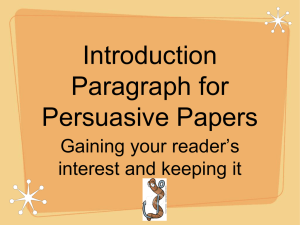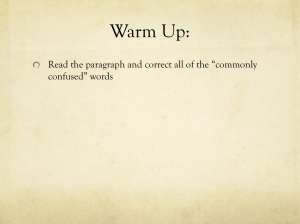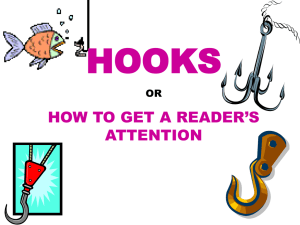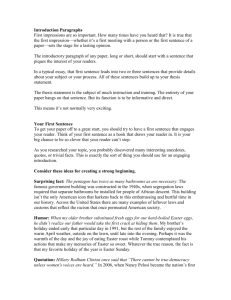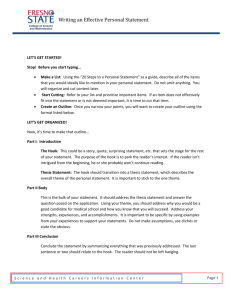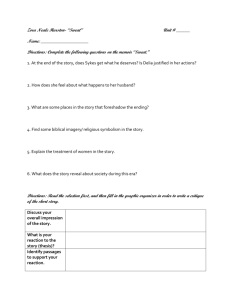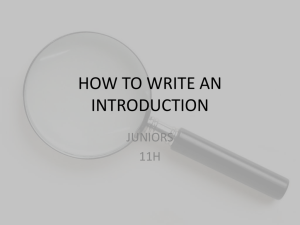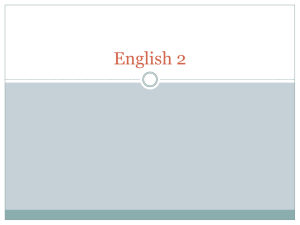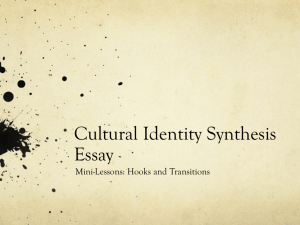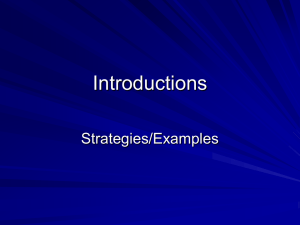paragraphs - Staff Portal Camas School District
advertisement
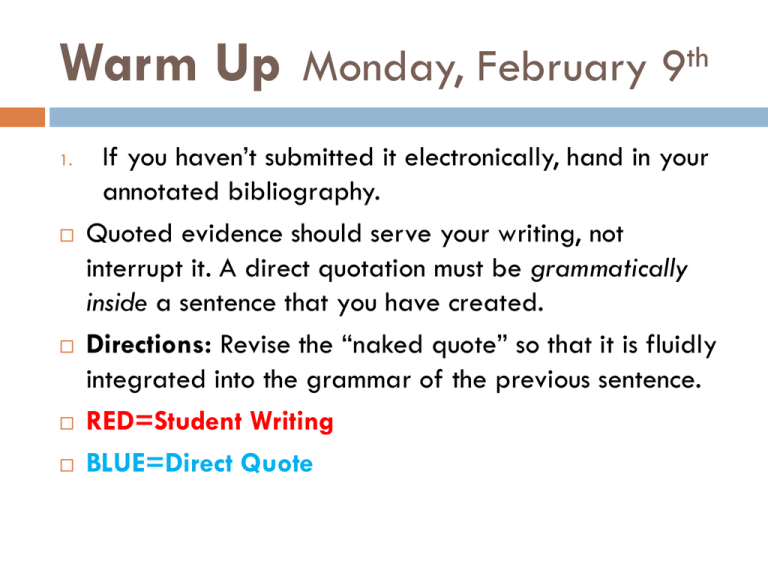
Warm Up Monday, February 9th 1. If you haven’t submitted it electronically, hand in your annotated bibliography. Quoted evidence should serve your writing, not interrupt it. A direct quotation must be grammatically inside a sentence that you have created. Directions: Revise the “naked quote” so that it is fluidly integrated into the grammar of the previous sentence. RED=Student Writing BLUE=Direct Quote Warm Up Slide – Integrating Quotes Many schools are changing policies to allow cell phones to be used for educational purposes in classrooms. “Teachers are finding that students are more engaged in activities when they can use their phones to take quizzes or respond to questions” (Smith). Learning Targets: To revise thesis statements To write hooks for introductory paragraphs. To write a rough draft of your introduction to your senior research essay. Hooks - Models Startling Statement - All human beings are capable of the most gruesome crimes imaginable. It is only because of the customs and controls of civilization that we do not become brute savages. Shocking Statistic - On a recent anonymous survey, over ninety percent of high school males admitted to secretly enjoying the music of 'N Sync and to practicing their "hot dance moves." Scenario - A close friend of mine was in the Vietnam War and he admitted to me that he was terrified every time he had to go into battle. Even so, I consider him one of the most courageous men I have ever known. It is not the absence of fear that defines courage, but the ability of one to force oneself to take action in spite of fear. Analogy - The models that grace the pages of magazines seem to be better than anyone we have ever met: they seem elegant, untouchable, and perfect. But, just as magazine covers are manipulated to hide imperfections, we, too, sometimes fool ourselves into ignoring the flaws of individuals whom we have built up to be perfect beings. Philosophical Musing - Why is it that, if a person were to have his or her navel suddenly disappear, we would think that their stomach looked weird? I mean, that darn navel thing is pretty weird just being there, don’t you think? Introductions - Hooks The Hook Use something surprising to grasp your audience’s interest: Students are often surprised to know that many of their instructors were not high-ranking students in their own graduating classes. In fact, one of the most well-respected Composition instructors here at Madeup University flunked Freshman English not once, but twice! Then, it comes back in your conclusion: Any student at Madeup University will tell you that the teachers who once struggled in their subject area are the most helpful. Remember that Composition teacher who flunked Freshman English twice? That was Mrs. Somebody--a popular Composition teacher and well-liked tutor in the Writing Center on campus. The best guides are those who've experienced the struggle themselves; these teachers truly help students climb toward academic success. Remember, it is not enough to hook your audience in the beginning. You also have lead them on a journey that comes back around in your conclusion. There is no such thing as “next season” in papers- so NO CLIFF HANGERS! Thesis Statements Must include your problem/issue, and a quick overview of each perspective on the problem. May be 1-2 sentences. What Goes Between the Hook and Thesis Statement? Here are the three main tasks that an introduction can accomplish: Connect/appeal to the reader. Anticipate their needs. Orient them to their coming “journey.” Intro. Strategy 1: Provide any background material important to your argument (anticipating reader’s needs). Intro. Strategy 2: Define key terms, as you intend to make use of them in your argument (anticipate their needs). So, how do you bridge between your hook and your thesis statement? Introduction – A Checklist A good introduction should… Describe what you plan to write about Give the reader some idea of how you plan to discuss or approach your topic Give background information on your topic (when appropriate) Include a clear, concise thesis statement Establish a connection between the writer and the audience Homework 1. 2. 3. Rough draft of intro – due at the end of class! A print out of all the sources you found last week (I’m hoping to see at least 10, and this list can be informal) Due tomorrow, 2/10 A Formal Works Cited sheet of all the research you intend to use. Due Friday, 2/13

